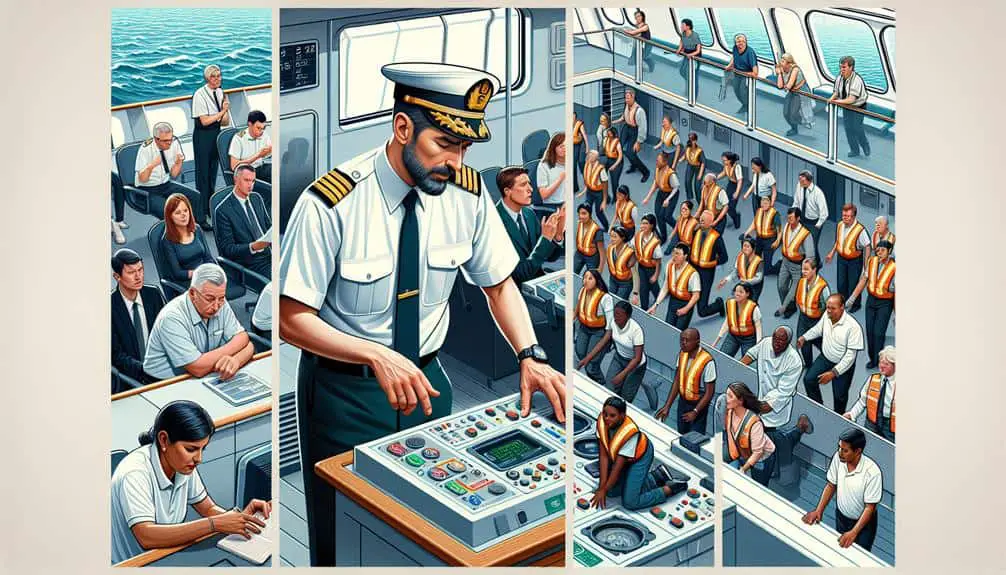Master the 7 essential tips for cruise ship risk assessment. Identify hazards, evaluate safety protocols, train crew well, conduct safety drills regularly, review regulations, monitor weather, and have a crisis management plan. Following these steps can guarantee smooth sailing and preparedness for any potential risks on a cruise ship. Following these tips can help you navigate safely and effectively on the high seas.
Key Points
- Regularly review safety standards and regulations for compliance.
- Monitor weather conditions closely for proactive risk management.
- Develop and practice a comprehensive crisis management and communication plan.
- Conduct frequent emergency response training sessions for crew members.
- Implement a robust risk assessment strategy to enhance overall safety preparedness.
Identifying Potential Risks
To identify potential risks on a cruise ship, carefully examine all aspects of the ship's operations and environment. Hazard identification is critical in guaranteeing the safety of passengers and crew. Start by preparing passengers before boarding with safety briefings and instructions on emergency procedures. During these sessions, emphasize the importance of attentiveness and compliance with safety protocols.
Next, conduct a thorough inspection of the ship's physical environment. Look for any potential hazards such as slippery surfaces, obstructed walkways, or faulty equipment. Ensure that proper signage is in place to alert passengers of any dangers and guide them to safety in case of an emergency.
Additionally, review the ship's operational procedures to identify any areas of concern. Evaluate how the crew handles emergencies, enforces safety measures, and communicates with passengers. By evaluating these aspects, you can proactively address potential risks and enhance the overall safety preparedness of the cruise ship.
Evaluating Safety Protocols
When evaluating safety protocols on a cruise ship, start by meticulously reviewing emergency response plans and evacuation procedures.
Scrutinize the effectiveness of communication systems in place and make certain they're reliable in all scenarios.
Additionally, assess the adequacy of safety drills and training programs for both passengers and crew members.
Safety Protocol Evaluation
When evaluating safety protocols for cruise ships, make certain that each aspect is thoroughly examined to guarantee the highest level of security for passengers and crew. Here are key points to contemplate:
- Safety Measures: Assess the adequacy of safety equipment such as life jackets, fire extinguishers, and evacuation procedures.
- Emergency Response: Review the efficiency of communication systems, crew training, and emergency drills.
- Compliance Checks: Ensure that safety protocols meet industry standards and legal requirements.
- Continuous Improvement: Establish a process for regular safety protocol reviews and updates based on feedback and incident analyses.
Risk Mitigation Strategies
Guarantee the thorough assessment of risk mitigation strategies by examining safety protocols to protect both passengers and crew on cruise ships. For effective risk prevention, make sure that safety protocols are up to date and align with industry standards.
Conduct regular drills and simulations to test emergency preparedness and response times. Implement clear communication channels and protocols for swift action during crises. Establish a chain of command to streamline decision-making processes in emergencies.
Regularly review and update safety procedures based on lessons learned from past incidents or near misses. Provide extensive training to all crew members on emergency procedures and equip them with the necessary tools to handle various scenarios effectively.
Prioritize a culture of safety onboard to minimize risks and ensure the well-being of everyone aboard.
Training Crew on Emergency Response
To ensure the safety of passengers and efficient response during emergencies, crew members must undergo rigorous training sessions on emergency response protocols. This training is vital for ensuring that the crew is well-prepared to handle any unexpected situations that may arise while at sea.
Here are some key aspects to keep in mind when training crew members on emergency response:
- Emergency Drills: Regular practice drills help crew members familiarize themselves with emergency procedures, ensuring they can react quickly and effectively during real-life situations.
- Role Assignments: Clearly defining roles and responsibilities within the crew during emergencies helps streamline communication and coordination, leading to a more organized response.
- Equipment Training: Familiarizing crew members with the proper usage of safety equipment and emergency tools enhances their ability to respond promptly and appropriately.
- Simulated Scenarios: Conducting simulated emergency scenarios allows crew members to apply their training in a realistic setting, identifying areas for improvement and enhancing overall preparedness.
Conducting Regular Safety Drills
You must understand the importance of conducting safety drills regularly to guarantee all crew members are prepared for emergencies. Assess the readiness of the crew through these drills to pinpoint areas that require improvement.
Encourage active participation from passengers to familiarize them with emergency procedures.
Drill Frequency Importance
Regular safety drills on a cruise ship are essential for maintaining preparedness and ensuring efficient emergency response protocols. Conducting drills at appropriate intervals can greatly enhance the safety levels aboard the ship. Here are some key reasons why drill frequency is important:
- Reinforcement: Consistent drills reinforce emergency procedures, ensuring they're well understood and easily executed.
- Proficiency: Regular practice increases the proficiency of crew members in handling emergency situations swiftly and effectively.
- Adaptability: Frequent drills allow the crew to adapt to different scenarios and challenges that may arise during emergencies.
- Evaluation: Conducting drills regularly enables the assessment of response times, identifies areas for improvement, and enhances overall emergency preparedness.
Crew Training Readiness
For optimal team training readiness in conducting regular safety drills, it's essential to establish a systematic schedule that guarantees thorough coverage of emergency scenarios. To ensure training effectiveness, crew members must participate in drills regularly. These drills should encompass various emergency situations such as fires, man overboard, or medical emergencies. Practice should focus on quick and efficient responses, communication protocols, and coordination among crew members.
Evaluating crew performance during these drills is crucial for identifying areas that need improvement to enhance emergency preparedness. By conducting regular safety drills with a structured approach, the crew can develop the necessary skills and confidence to handle emergencies onboard effectively. Consistent training fosters a culture of preparedness that's vital for ensuring passenger safety.
Passenger Participation Encouraged
To enhance overall safety readiness on cruise ships, engaging passengers in regular safety drills is a proactive measure to bolster emergency response capabilities. By involving passengers in these drills, cruise ships can guarantee that everyone is prepared for potential emergencies, contributing to a safer onboard environment.
Here are some key points to ponder:
- Passenger feedback: Encourage passengers to provide input on safety drill procedures for continuous improvement.
- Safety drills effectiveness: Regular safety drills improve passenger engagement and familiarity with emergency protocols.
- Emergency response readiness: Increased passenger participation enhances the speed and efficiency of emergency responses.
- Onboard safety culture: Involving passengers in safety drills fosters a culture of preparedness and collective responsibility.
Reviewing Compliance With Regulations
When evaluating cruise ship risk, conduct a thorough examination of adherence to regulations. Compliance verification is essential in guaranteeing the safety and security of all passengers and crew on board. Begin by reviewing the vessel's compliance with international maritime regulations set forth by organizations like the International Maritime Organization (IMO). Check that the ship meets all safety standards, including proper lifeboat capacity, fire safety measures, and emergency response protocols. Additionally, verify compliance with specific regulations governing environmental protection, waste disposal, and sanitation practices.
Next, assess the ship's adherence to industry-specific regulations established by bodies like the Cruise Lines International Association (CLIA). These regulations cover a wide range of areas, including passenger safety, health standards, and operational procedures. Pay close attention to any recent updates or changes in regulations to make sure that the ship remains in full compliance.
Monitoring Weather Conditions
Be diligent in monitoring weather conditions throughout the duration of the cruise, guaranteeing real-time awareness of potential risks and the ability to take proactive measures as needed. Weather monitoring is a critical aspect of cruise ship safety. Here's how you can effectively monitor weather conditions for emergency response:
- Utilize Weather Forecast Services: Subscribe to reliable weather forecast services that provide up-to-date information on changing weather patterns.
- Establish Communication Protocols: Ensure clear communication channels with relevant authorities and crew members to disseminate weather-related updates promptly.
- Implement Monitoring Schedule: Create a structured schedule for regular weather checks to stay informed about any sudden changes that may pose risks.
- Train Crew on Emergency Protocols: Conduct training sessions to educate the crew on emergency response procedures in different weather scenarios to enhance preparedness.
Implementing Crisis Management Plan
Guarantee the prompt implementation of your cruise ship crisis management plan by mobilizing designated response teams and coordinating emergency protocols effectively. To make certain a seamless response to crises, it's crucial to have a well-defined incident response plan in place.
Conduct regular emergency response training sessions to familiarize all crew members with their roles and responsibilities during a crisis. Establish clear communication protocols that outline how information should be disseminated internally and externally in case of an emergency.
Additionally, develop crisis communication strategies that address various scenarios, such as medical emergencies, natural disasters, or onboard incidents. These strategies should include guidelines on how to communicate with passengers, authorities, and the media to maintain transparency and ensure accurate information is shared.
Frequently Asked Questions
How Often Should Cruise Ships Conduct Safety Drills?
You should conduct safety drills on cruise ships regularly to guarantee everyone is prepared for emergencies. By practicing emergency procedures frequently, you can improve response times and overall safety measures onboard.
What Specific Regulations Do Cruise Ships Need to Comply With for Safety?
To guarantee safety compliance, cruise ships must adhere to specific regulations such as SOLAS and MARPOL. Conducting thorough risk assessments, implementing emergency response plans, and providing detailed training protocols are essential for safeguarding passengers and crew.
How Are Crew Members Trained on Handling Medical Emergencies?
When it comes to crew training, emergency response is a top priority. Crew members undergo rigorous training sessions that cover a range of medical emergencies, equipping them with the necessary skills to handle critical situations onboard.
What Measures Are in Place to Prevent Fires on a Cruise Ship?
To prevent fires on a cruise ship, fire suppression systems like sprinklers and alarms are installed. Emergency response drills are conducted regularly to guarantee crew readiness. Safety protocols dictate prompt detection, containment, and evacuation procedures.
How Does a Cruise Ship Handle Communication During a Crisis Situation?
During a crisis situation on a cruise ship, crisis communication is essential for emergency response. Clear instructions are given over the ship's intercom system, directing passengers to muster stations or providing updates on the situation.




